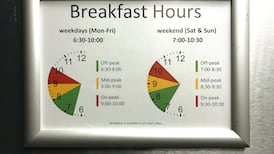The book of Ecclesiastes tells us there is “a time to weep, and a time to laugh”. The strict dichotomy between weeping and laughter that this implies does not, however, ring true.
Most people need to mingle the two, to leaven sorrow with humour, for the sake of our sanity. Accordingly, many of us – whether cocooning, or just observing social distancing rules – have been exchanging jokes and cartoons via the electronic media in recent months in an effort to cheer one another up.
Perhaps because of our troubled history, we Irish have a fine tradition of humour
This activity reflects one of the three classical theories of humour. The first of these is superiority theory – humour as derision or mockery, with a victim as the butt of humour.

The second is incongruity theory – humour as a response to the illogical or unexpected. The third is relief theory, which posits that humour serves to release tensions – and that is the one relevant to our present circumstances.
Humour by this reckoning is a form of therapy. It is, in the words of the well-known British academic Mary Beard, "the emotional equivalent of a safety valve".
The literary critic, Terry Eagleton, likewise, uses the metaphor of the "safety valve" in his recent study of humour. He writes that humour "provides a safety valve for . . . subversive energies. In this sense, its closest parallel today is professional sport, the abolition of which would no doubt be the shortest route to bloody revolution."
Humour, in other words, turns our discontents and anxieties into a joke, and helps to reconcile us to our fate.
In the same vein, the editors of Dublin Opinion, Ireland’s best ever satirical journal, claimed “that humour is the safety valve of a nation, and that a nation which has its values right will always be able to laugh at itself”.
Perhaps because of our troubled history, we Irish have a fine tradition of humour. We are a naturally irreverent people. Swift is the pre-eminent exemplar of this, but the late Prof Vivian Mercier has argued that what he called the "Irish comic tradition" is the central one of Irish and Anglo-Irish literature and can be traced back to oral Gaelic roots in the ninth century.
He identified the elements of this tradition as "a bent for wild humour [and] a delight in witty word play". It continues right down to the present day, through Wilde and Shaw, to Roddy Doyle – even to the Father Ted sitcom.
We can trace it too in cartoons, from the iconic images published by the Freeman’s Journal and United Irishman newspapers in the 1880s, through Dublin Opinion in the first half of the 20th century, to Martyn Turner in this newspaper today.
Two cartoons that have recently come on my radar address, and through laughter may alleviate, the frustration many people have felt at being unable to attend church services in person due to Government restrictions on gatherings.
One shows a woman walking up the aisle of a church in a somewhat dishevelled state, still in dressing gown and goofy slippers, and carrying a mug of steaming coffee. The caption reads: "Mrs Jones got a little too used to watching online worship from home".
In short, humour is a safety valve – and no matter how bad things get, let us hope that we never lose our capacity to laugh at whatever life throws at us
The other is of St Peter at the Pearly Gates addressing a group of new arrivals who expect to gain admission. He tells them: "And to you who did not actually go to church but watched it on television, you will not actually go to heaven – but will be allowed to watch it on television".
These are models of how a sensitive topic can be treated with humour, and tensions thereby defused.
I will give the final word to Martin Rowson, one of the best of contemporary British cartoonists. Writing about his own particular brand of humour, he says that "satire in general and cartoons . . . exist because we need them – to contextualise the greater hideous, often horrific absurdities of reality into a manageable and therefore controllable format which might then also make us laugh and thus feel better".
In short, humour is a safety valve – and no matter how bad things get, let us hope that we never lose our capacity to laugh at whatever life throws at us.









